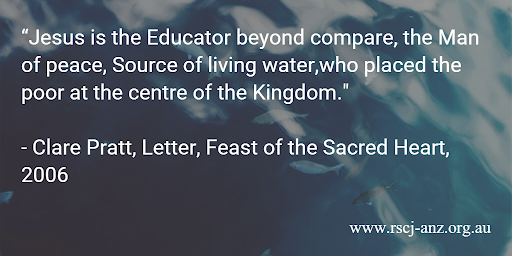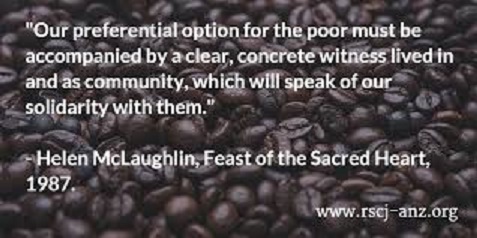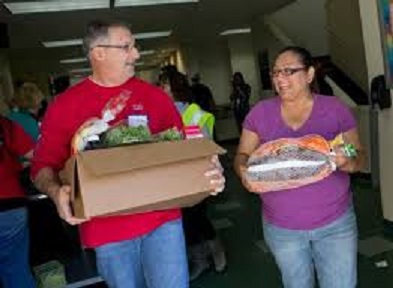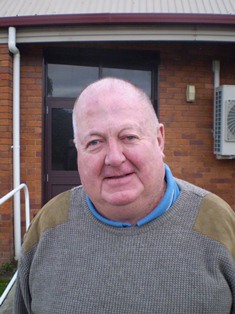50 Years Ago – Poorman Masses Emerged.
John O'Connor MSC, who celebrated his Golden Jubilee of Priesthood last weekend reflects on this experience and his experience.
In 1969, some 50 years ago, “The Poorman Masses” began as part of celebrations for the Feast of the Sacred Heart at St Patrick’s Cathedral in Melbourne. After 10 years, the MSC care of the Sacred Heart Day needed new energy; but, how this was to be done was a real conundrum.

“Poverty is painful – even in Melbourne” became the theme that challenged the common belief that poor lived in foreign nations. Religious sisters ministering in public high rise tower housing found it was sadly too common.
In response to this, bringing gifts for the poor during the Eucharist on Sacred Heart Day took seed. The idea of asking people not only to attend Masses at the Cathedral but also to bring gifts for the poor seemed to be fool-hardy. Why make the task harder? The dean of the cathedral was sceptical that even one tea chest would be filled when told a dozen had been provided by a local business to place around St Pat’s.
Cyril Hoy manager of Ozanham House, Vinnies’ shelter for homeless men in Melbourne was enthusiastic in his support. St Vincent de Paul was a vital partner of Poorman Masses, especially in distributing gifts to the poor.
A vital element of the promotion was a catchy title. The expression “a poorman’s …” denotes doing well with limited choices – a poorman’s Merc. “Poorman’s Mass” was edgy. “Poorman Masses” was more accurate and easier to say.

MSC Philippines
A giant sign in red print was prominently displayed at the cathedral: “Friday 13th Poorman Masses”. Might it be read as a political manifesto? Might Cardinal Knox object?
The media were contacted – including cinema advertising, radio, TV stations and press. Catholic schools received promotional material requesting they support the Youth Mass in the morning; but was it all whistling in the wind?
Friday 13th finally arrived. As the bus bringing MSC seminarians from Croydon neared the cathedral, groups of school students were being herded along the footpath by teachers; each child clinging to tins of food or packets of breakfast food. What a welcome sight! There was at least this much response.
By the end of the day, there were big piles of food and clothing – including fine business suits newly dry-cleaned inside the cathedral. A pound of butter happily survived the day on the cold tile floor of the cathedral. The offertory procession was marked by Cardinal Knox wearing his mitre, receiving boxes of cereals and cans of baked beans which were placed around the altar.
At the end of the day, Cyril Hoy estimated about 10 tons of food and clothing had been donated during the day. He calculated the number of trips in his battered Holden station wagon weighed down to the axles to Ozanham House. Donated food was enough for a year at Ozanham House. What might result if all parishes hosted their own Poorman Masses? Would this detract from the Sacred Heart Day at the Cathedral? It was decided it be best that all parishes be involved in future. This of course, meant much dedicated organization by MSC students and priests from then on.
What emerged at the end of the day was a conviction that regardless of the work and the risks taken, this result was the work of the Spirit; success or failure was irrelevant.
Serving the poor is a work of love – a glass of water in his name; do unto others as you would they do unto you; whatever you did to the least, you did it to me … such are familiar Gospel axioms.
“The Poorman Masses” expresses other theological values.

One could ask who is the poor man? Is it those who gain help from Vinnies; or, perhaps, those who come selflessly to worship; or, perhaps Christ himself who emptied his divinity to become fully human? Biblical poverty is the gift of being free to be open to God without compromise.
The Jewish prayer – the Berakah is an ecstatic prayer of selfless gratitude to God for all that one is and has; as in the Offertory “Blessed are you Lord God of all Creation for through your goodness we have this bread to offer, fruit of the earth and work of human hands. It will become for us the bread of Life!” The Eucharist is joyful thanksgiving with no self-concern; we are transformed into the movement of the Son to the Father.
The biblical tradition of dedicating the first fruits, the best of the best as a selfless offering of all that one is and has appears in later traditions of harvest festival liturgies. Liturgists see the Sunday collections as equivalent for today’s urbanised society.
Sacred Heart is the icon of God’s heart with limitless love on fire for all - especially the sinful and hopeless. It is the image of what we are called to be – happily selfless in service of all and of God – so the Sacred Heart of Jesus may be everywhere loved forever. In the Poorman Masses, we express liturgically and wholeheartedly our thanks to God in a simple yet rich combination of a variety of themes that at heart speak of selfless love to God.
This is best expressed by Mary in her Magnificat and as seen by Jules Chevalier as “Our Lady of the Sacred Heart”.
The task of continuing the Poorman Masses down the years has been taken on by many dedicated MSC and others. It seems to have served the Church for many years beyond the Archdiocese of Melbourne.
In recent years, it seems to have largely disappeared from parishes; but, it does survive in modest form here and there at school liturgies and retreats. It goes without saying that self-perpetuating is hardly part of its spirit.
With thanks to the recent MSC Magazine

